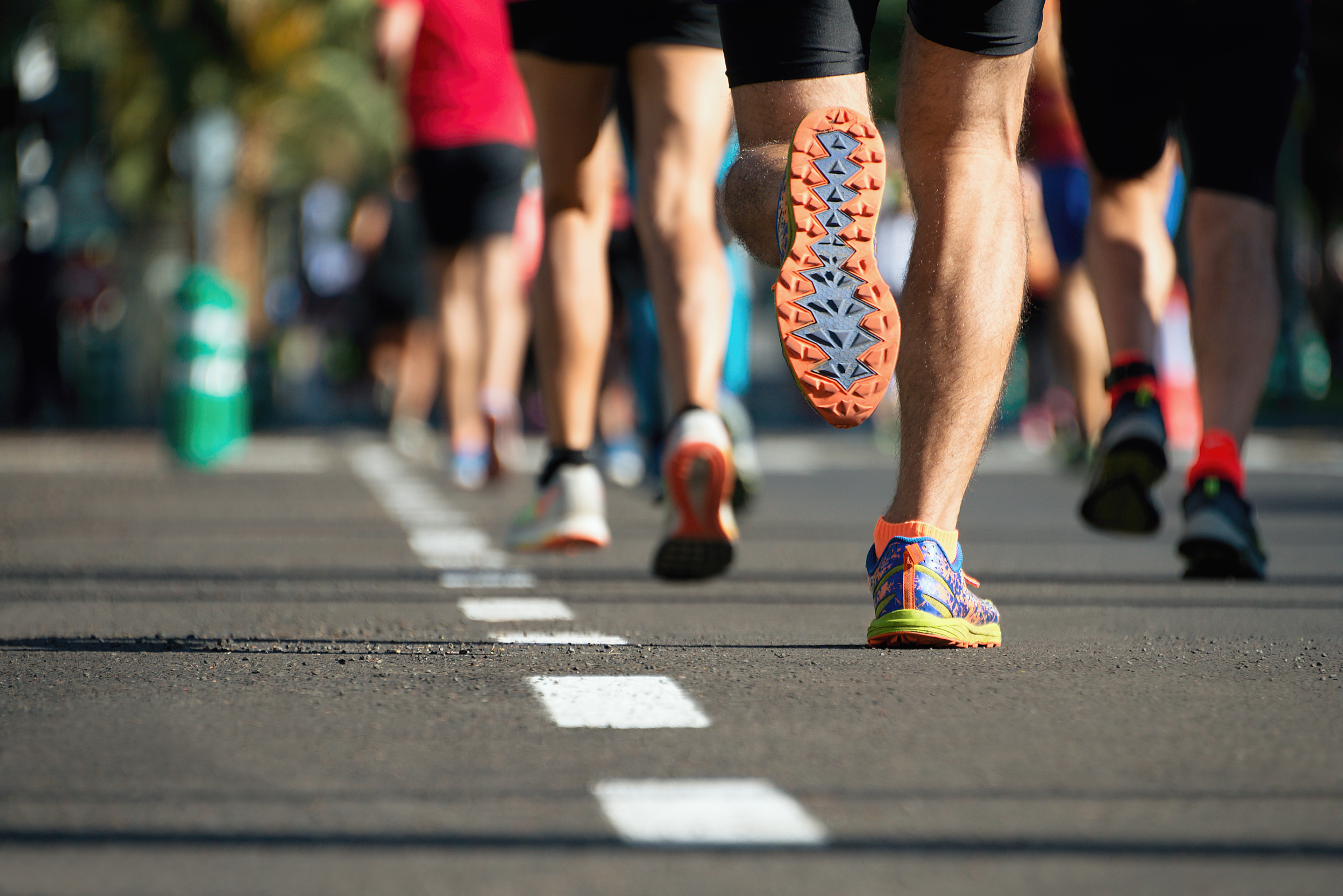
Pavel1964/Getty Images
How to Find Your Race Pace (and Use It to Crush Your PRs)
Your race pace should be the centerpiece of your training strategy, regardless of whether you're a first-time racer or an ultramarathoner.
By Colleen Travers, Sarah Klein•
What Is Race Pace?
How to Find Your Race Pace
How to Improve Your Race Pace
How to Find Your Race Pace on Race Day
The Takeaway
If you’re training for a race, you probably want to find a pace that won’t burn you out but also won’t leave you with leftover fuel in the tank. This Goldilocks number is known as your race pace, and it’s key to reaching your goal time.
Of course, that doesn’t mean you have to do all of your training runs at the same pace. If you’re going longer distances and working on your endurance, you’re likely to go slower, but HIIT and interval runs may have you moving faster for a shorter amount of time. Switching it up and running at different speeds can play an important role in your training.
Here, we explain what race pace is and ask Peloton instructor Becs Gentry for her best tips on building an effective race-pace strategy.
What Is Race Pace?
Your race pace should be comfortably uncomfortable but possible to maintain mile after mile with a fair amount of effort. In fact, you probably haven’t run at your race pace yet.
“Your race pace is what I would call your ‘go-getter’ pace,” Becs says. “When you race, the goal is [often] to achieve a PR, so the speed you run at is going to be faster than what you can achieve in your training.”
Cyclists can think of race pace as the running equivalent of the Functional Threshold Power test on the Peloton Bike.

Guido Mieth/Getty Images
Why Is Race Pace Important?
Knowing your race pace is beneficial during training and on race day. During training, you’ll use your race pace to gauge your effort during other types of runs. For example, your recovery runs should be slower than your race pace, whereas your tempo runs should be a bit faster (depending on the length of the race you’re training for).
Plus, knowing your race pace will keep you on track during the actual race. It’s tempting to start out fast, especially on flat courses or during shorter races, but if you do, you’ll risk hitting a wall before crossing the finish line. Your race pace can act as a helpful guide rail to ensure you’re pushing yourself without burning out.
How to Find Your Race Pace
The sooner you find your race pace, the sooner you can start building a training plan around it. The good news? You don’t have to be a seasoned racer to zero in on the optimal number for you.
There are a few different ways you can arrive at this number.
1. Examine Recent Race Paces
One straightforward way to figure out your race pace is to get out and race. Look at the most recent races you’ve run to get a sense of the speed you’ve built.
You can then plug your average mile time from your past races into an online race pace calculator, such as this one from Active, that can automatically adjust your pace for races of different distances.
2. Do a Time Trial
New to the racing scene? Not to worry. “If you haven’t run a race, do your own time trial for a mile or a 5K,” Becs suggests. “From there, you’ll be able to more closely determine your pace targets.” Keep in mind that your pace will vary based on the distance you run—a mile-long sprint won’t be the same speed as your mile splits during a 5K—so make sure you time yourself for the length of the race you plan to run. For longer endurance races, such as marathons or half-marathons, run at a tough pace for an hour and use that mile split as your baseline with the online calculator above.
3. Consider Pacing by Heart Rate
Rather than focus on minutes per mile, you could instead maintain a certain level of intensity on race day, measured by your heart rate. Heart rate training (and racing) involves identifying your maximum heart rate and then using that number to establish five heart rate zones of increasing intensity. This involves a little math, but we walk you through the entire process in our guide to calculating your ideal running heart rate. Depending on your goals and the distance you’re racing, your race pace might land in Zone 3 or Zone 4.

How to Improve Your Race Pace
Once you’ve found your race pace, the next step is to maintain or improve it. Here’s how to add race-pace workouts to your training plan so you can hit your target on race day (and maybe even pick up speed). Peloton’s Pace Target classes or four-week Push Your Pace program, available on the Peloton App, Peloton Tread, or Peloton Tread+, can also help you get there!

Peloton App
Access thousands of classes with no equipment needed.
Tempo Runs
“A tempo run is more or less your race pace for a shorter time or distance than the race,” Becs says. “You don't want to be hitting race pace for extended periods of time in training because you want to save that energy for the actual race day. Training is planned around building you up to hit race pace.”
To work tempo training into your plan, try an outdoor run on the Peloton App and filter for speed or check out a Pace Target class. When you’re crafting your training plan, aim to incorporate one tempo run per week in your schedule.
Interval Workouts
Unlike tempo runs, where you maintain what’s close to a race pace for an extended amount of time, interval workouts alternate between fast bursts of speed and leisurely recovery periods. Interval workouts increase your heart rate and improve aerobic endurance, two benefits that can boost your performance on race day.
Yasso 800s
Yasso 800s is a track workout that’s well-known by many runners, especially those who love longer distances. It’s designed to mimic the feeling of running a marathon at your marathon race pace.
First, convert your target marathon finish time from hours and minutes to minutes and seconds (for example, a 4:30 marathon time would be converted to four minutes and 30 seconds). Next, you’ll run 800-meter repeats, aiming to finish each one in four minutes and 30 seconds. Once you’ve finished, rest, walk, or jog for the same amount of time. Start by completing three or four Yasso 800s, then add one rep each week until you reach 10.
Not a marathoner? You can adapt this workout for shorter distances by using your half-marathon time and running 400 meters instead of 800 meters. No matter which modification you take, you’ll still be running with more effort for longer spans of time—which is key to improving your race pace.
Hills
Adding hills to your race-pace workouts can help you get faster, regardless of whether you work them in during your outdoor runs or your time on the Peloton Tread.
Running hills strengthens your leg muscles and core, helping you move faster. Plus, running uphill is a solid way to improve your form; you’ll learn to engage your core and glutes, drive your knees, and run with a slightly forward lean. These form adjustments will help ramp up your speed, even when there’s no hill in sight.
How to Find Your Race Pace on Race Day
No matter how dedicated you are to your training plan, you’re not going to shave 30 seconds off your race pace overnight—or even over a week, for that matter. Remember that building speed takes time, so you may need to set smaller goals along the way before reaching your fastest race pace.
“In order to work toward hitting a new PR at a race, you need to follow a structured training plan and trust that process,” Becs says. “There will be tough days and easy days, but working hard and seeing the adaptations over time will encourage you to keep going.”
When race day finally arrives, it’s natural to feel nervous about hitting your goal. But with the right mindset, you can prepare yourself for any jitters and hit the ground running.
Run Through a Dress Rehearsal
During one of your last race-pace training workouts, try your best to mimic your race-day schedule. Wake up at the same time you will on race day, eat your pre-race breakfast, and wear the running gear you plan to race in so you’re not surprised by any blisters or chafing. Try to get close to your race pace so you get a feel for the effort level—without relying too much on your smartwatch.
Practice Mindfulness at the Start Line
In the last few moments before the race, dial into your breathing and center yourself. Try a full-body scan, box breathing (inhaling to the count of four and exhaling to the count of four), or even a meditation on the App. Having a calm mind will help you focus on your race-pace strategy once you start moving (and hopefully keep you from going out too fast).
Run Conservatively at the Start
We’ve been emphasizing the risks of taking a race out too fast for good reason. Many experienced runners have gotten caught up in the crowd’s energy and the excitement surrounding the starting line, only to push their pace and lose steam. Use the first leg of your race to set the foundation for the rest, with steady breathing and smart pacing. Remember: You can always speed up later in the race if you feel up to it.
Check Your Pace, but Don’t Obsess Over It
Depending on the length of your race, you may want to check your pace and compare it to your goal race pace every five minutes, every kilometer, or even every mile. Go ahead, but don’t obsess over your pace; it’ll only take up extra mental space. Plus, taking time to repeatedly check your watch and make mental calculations can wind up slowing you down. Check your race pace regularly, adjust accordingly, and repeat. From there, do your best to enjoy the miles in between.
Listen to Your Body
Above everything else, remember to check in with yourself throughout a race. If something hurts or doesn’t feel right, take it down a few notches to ensure you’ll be able to chase that race pace in the future.
The Takeaway
Your race pace is a comfortably uncomfortable running pace you can maintain during a race of a specific distance to push yourself without burning out or leaving too much energy in your tank. There are several different ways to calculate race pace, including using past race times and doing a time trial. Once you’ve identified a race pace you want to aim for, you can adjust your training plan to include interval workouts and hill running to build speed and power. On race day, trust your training and try not to obsess over your time; listen to your body so you can cross this finish line—and future ones—injury-free.
This content is for informational and educational purposes only and does not constitute individualized advice. It is not intended to replace professional medical evaluation, diagnosis, or treatment. Seek the advice of your physician for questions you may have regarding your health or a medical condition. If you are having a medical emergency, call your physician or 911 immediately.
Level up your inbox.
Subscribe for a weekly dose of fitness, plus the latest promos, launches, and events.
By providing your email address, you agree to receive marketing communications from Peloton.
For more about how we use your information, see our Privacy Policy.









